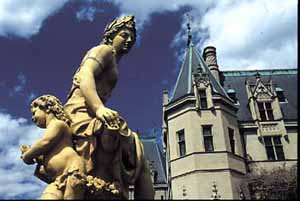
The historic elegance of the Biltmore House has
been
a favorite site for film producers through the years
See the 'Paris
of the South' on foot
Having
been host to nearly 6.5 million visitors in 2000, Asheville ranks near
the top of the state when it comes to tourism revenue. Centered around
world-class attractions like the Biltmore Estate, the Blue Ridge
Mountains and the fabled Grove Park Inn, Asheville boasts a tourism
industry that is more sophisticated and well-marketed than most cities
its size.
But there’s far more to see in Asheville — the “Paris of the
South” — than simply those dependable standbys, much of it focused
on the city’s energetic and youthful downtown. In 2000, a new
“Urban Trail” was unveiled that takes visitors through a 1.6-mile
walk through various periods of Asheville’s colorful history.
“About 10 years ago, several downtown initiatives were coming
together,” recalls Leslie Anderson, an Asheville organizational
development consultant who chairs the city’s Urban Trail Committee.
“We began to ask ourselves, ‘What could we do to create some
unifying themes’?”
Designing a downtown loop trail was the solution, and with support of
public, private and philanthropic funds, Anderson and others embarked
on weaving together 30 interpretive stops along the route. Each
station would touch on something uniquely Asheville — its commerce,
culture, art, politics or architecture. “We knew there were a lot of
nooks and crannies we could tie together,” Anderson says.
Included on the trail is a walk down Wall Street, where visitors can
admire Asheville’s Flat Iron Building. The oddly shaped structure
was built during the height of the Art Deco era and modeled after its
larger Manhattan counterpart. They are then greeted by the hammering
and banging going on as part of the renovation of the block-long Grove
Arcade, soon to be a mixed-use complex featuring locally-owned shops
and “day tables,” restaurants, office space and high-end
residential units.
The 269,000-square-foot building was constructed in 1926 by tonic
magnate E.W. Grove, founder of the Grove Park Inn. It was among the
world’s first indoor shopping malls. Restoration efforts are
expected to be complete in early 2002.
The marketplace portion of the project is being funded through the
issuance of $2.25 million in bonds by the city of Asheville.
Renovation of the mezzanine, second, third, and fourth floors of the
Arcade is being financed by Progress Energy (formerly CP&L),
which, along with the city and a private foundation, is a partner in
the effort. Estimates are that as many as 700 jobs will be created at
the arcade.
“The Grove Arcade fits neatly into what has been a ‘new
urbanism’ that’s catching on here,” says Mac Williams, an
economic developer with the city of Asheville. The style, he explains,
involves a higher density, mixed-use approach that has the added
benefit of boosting the revenue-generating capacity of land downtown.
That, in turn, firms up the city’s tax base. “In an area whose
land is constrained by mountains, making the most efficient use of it
is paramount,” he says.
Williams and other leaders are also excited about the progress being
made in resuscitating Asheville’s riverfront area. “Other U.S.
cities have successfully re-developed their waterfronts to form the
basis of their identity,” says Williams, ticking off a list that
includes Baltimore, San Antonio and Boise, Idaho. Achieving this, he
admits, is a far longer-term prospect.
Yet, with the financial support of local, state and federal
governments, private foundations and the public contributions,
Asheville now has its first greenway. Running along French Broad River
Park, the space has a half-mile trail, a pavilion, enhanced wetlands,
observation decks, native wildflower beds, picnic facilities and more.
Currently under development is another half-mile of greenway along
Amboy Road that will contain fishing and boat access, trails and
boardwalk over the wetlands.
“In the early days (mid-1980s), it was hard to find funding,”
recalls Karen Cragnolin, executive director of Riverlink, a nonprofit
group that is leading the redevelopment effort. “It’s different
now. There’s a lot of support for this.”
A “Studio Stroll” was begun in 1993 as part of an effort to
attract attention to the riverfront and its potential. Though only a
handful showed up for the first tour, interest quickly swelled. Now,
Riverlink sponsors the event twice yearly. “These days, people just
flock here from all over for it,” Cragnolin says. — Lawrence
Bivins
Return to main article
Return to magazine index
|
|

